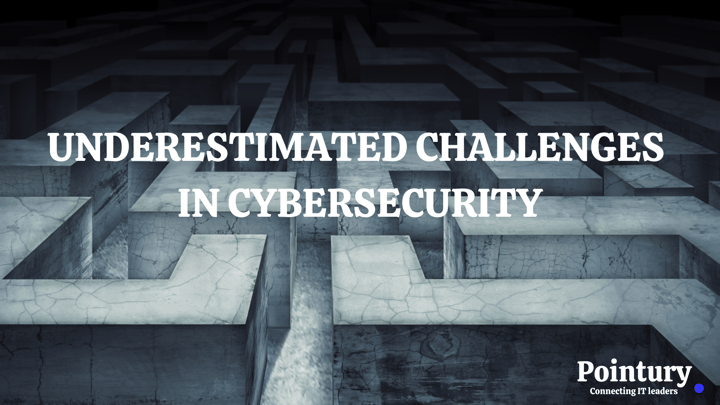UNDERESTIMATED CHALLENGES IN CYBERSECURITY

Underestimated Challenges in Cybersecurity:
Mitigating Risks through Comprehensive Strategies
In today's digital age, cybersecurity has emerged as a critical concern for organisations across the globe. With the increasing sophistication and frequency of cyber threats, having a robust cybersecurity strategy in place is no longer optional; it's an imperative. The importance of a comprehensive cyber risk mitigation strategy cannot be understated, considering the dire consequences that security breaches can have on an organisation's operations, reputation, and bottom line.
The Underestimated Challenges in Cyber Risk Mitigation
While the significance of cybersecurity is widely acknowledged, several challenges are often underestimated, hindering effective risk mitigation strategies.
1. Scarcity of Cybersecurity Professionals
One of the foremost challenges in the realm of cybersecurity is the scarcity of skilled professionals. The demand for cybersecurity experts has skyrocketed, driven by the escalating threat landscape and the increased reliance on digital infrastructure. However, the supply of qualified professionals has not kept pace with this demand. Organizations struggle to fill critical cybersecurity positions, leaving them vulnerable to potential cyber threats. Without a dedicated and competent team, an organization's ability to effectively detect, prevent, and respond to cyber threats is severely compromised.
2. Proliferation of Disparate Security Tools
The cybersecurity landscape is inundated with a multitude of security tools and technologies designed to address various aspects of security. While these tools are intended to fortify an organization's defenses, the sheer volume and lack of native interoperability among them present a significant challenge. Many organizations end up with a fragmented security infrastructure, employing numerous disparate tools that do not seamlessly communicate or share information. This fragmentation can result in inefficiencies, increased complexity, and gaps in security coverage, making it difficult for even experienced IT leaders to effectively manage and utilize these tools optimally.
3. Evolving Cyber-Threat Landscape
Cyber threats are evolving at an alarming pace, becoming more sophisticated, targeted, and difficult to detect. The diversity and complexity of cyber threats continue to grow, encompassing various attack vectors such as ransomware, phishing, advanced persistent threats (APTs), and more. Organizations must remain vigilant and adapt swiftly to keep pace with these evolving threats. Failure to understand and anticipate the dynamics of the cyber-threat landscape can lead to inadequate defense mechanisms, leaving an organization exposed and susceptible to cyber-attacks.
Crafting a Holistic Cyber Risk Mitigation Strategy
To address these underestimated challenges effectively, organizations need to develop a comprehensive cybersecurity strategy that acknowledges and mitigates these risks proactively. Here are some key components of a robust cyber risk mitigation strategy:
1. Investing in Workforce Development
Addressing the scarcity of cybersecurity professionals requires a strategic focus on workforce development. Organizations should invest in training programs, partnerships with educational institutions, and upskilling initiatives for existing IT staff. Creating a pipeline of skilled cybersecurity professionals is essential to ensure a strong defense against cyber threats.
2. Consolidating and Streamlining Security Tools
To combat the challenge of disparate security tools, organisations should conduct a thorough evaluation of their existing security infrastructure. Consolidating tools where possible and investing in integrated solutions that offer seamless communication and central management can significantly enhance an organisation's security posture. Streamlining the security stack reduces complexity, making it easier to monitor and respond to security events.
3. Embracing Threat Intelligence and Proactive Monitoring
Staying ahead of the evolving cyber-threat landscape requires a proactive approach. Organizations should leverage threat intelligence platforms and constantly monitor emerging threats. This allows for a proactive response to potential risks, enabling the organization to fortify its defenses before a cyber-attack occurs.
4. Regular Training and Awareness Programs
Human error is often a weak link in cybersecurity defenses. Conducting regular cybersecurity training and awareness programs for employees can significantly reduce the risk of successful phishing attempts and other social engineering attacks. Educated and aware employees can serve as an additional layer of defense against cyber threats.
5. Incident Response and Business Continuity Planning
Preparing for the inevitable is a crucial aspect of cybersecurity. Establishing a well-defined incident response plan and robust business continuity strategy ensures that, in the event of a cyber-attack, the organization can respond effectively, minimize damage, and resume operations swiftly.
Conclusion
The modern cybersecurity landscape is a dynamic and challenging environment that demands a proactive and holistic approach to risk mitigation. Recognizing the underestimated challenges, such as the scarcity of cybersecurity professionals, the proliferation of disparate security tools, and the evolving threat landscape, is the first step in building a comprehensive cyber risk mitigation strategy. By investing in workforce development, consolidating security tools, embracing threat intelligence, conducting regular training, and ensuring effective incident response and business continuity planning, organizations can bolster their cybersecurity posture and effectively navigate the ever-changing cyber-threat landscape. A proactive and adaptive cybersecurity strategy is the key to protecting valuable assets and maintaining the trust and confidence of stakeholders in today's digital age.


